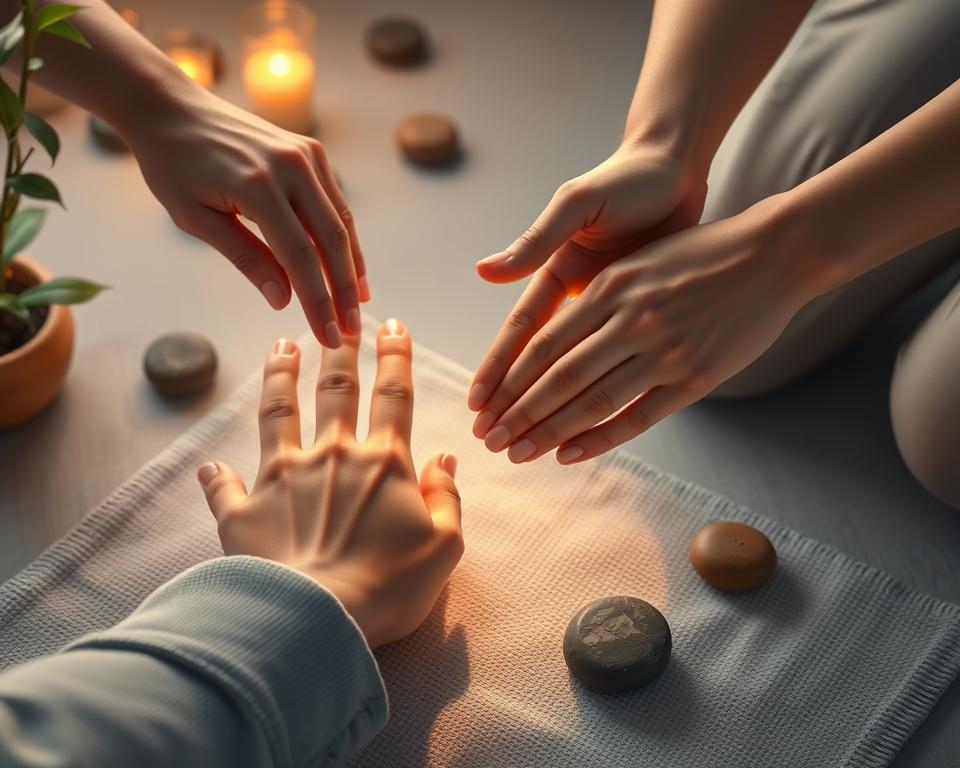Rheumatoid arthritis is a chronic condition that affects many people’s lives. It can make everyday activities hard. But, there’s hope in the form of acupressure, an ancient Chinese practice.
Acupressure works by applying pressure to certain points on the body. It helps reduce pain, improve movement, and boost overall health. This makes it a valuable tool for those with rheumatoid arthritis.
Looking into acupressure for rheumatoid arthritis can reveal natural ways to manage the condition. It’s a holistic approach that can be used alongside traditional treatments. By using acupressure, people with rheumatoid arthritis can improve their quality of life and lessen their need for medication.
Read more interesting information at ::lesdamesmiami
Understanding Rheumatoid Arthritis
Rheumatoid arthritis is an autoimmune disorder that mainly affects the joints. It causes inflammation, pain, and stiffness. This condition has many symptoms of rheumatoid arthritis and causes that can greatly affect a person’s daily life.
Symptoms and Causes
The common symptoms include joint swelling, tenderness, and reduced range of motion. These symptoms often hit the smaller joints in the hands and feet. But, they can also affect larger joints like the knees and hips.
The root cause is an immune system malfunction. The body’s defense attacks its own tissues, causing inflammation and joint damage.
Impact on Daily Life
Rheumatoid arthritis can make everyday tasks hard. The pain, stiffness, and mobility issues can hinder simple actions. For example, opening jars, buttoning shirts, or even getting dressed becomes a challenge.
In severe cases, it can lead to disability and impaired physical function. This makes it tough to stay active and independent.
But, there are treatments and management strategies to help. Understanding the symptoms of rheumatoid arthritis, causes, and impact on daily life is key. It’s the first step in finding an effective treatment plan.
What is Acupressure?
Acupressure is an ancient Chinese healing method. It uses touch to help with health issues, like rheumatoid arthritis. It involves gentle pressure on certain body points to help heal naturally.
The principles of acupressure come from traditional Chinese medicine. It says our body’s energy, or qi, moves through meridians. When this flow is blocked, health problems can occur. Acupressure tries to fix this flow to ease symptoms and boost health.
How does acupressure work? Pressing on acupressure points starts the body’s healing process. It releases endorphins, which are natural pain relievers. This can lessen pain, reduce swelling, and help move better, which helps those with rheumatoid arthritis.
| Acupressure Principles | Explanation |
|---|---|
| Meridians | Invisible energy pathways that run throughout the body, carrying the vital life force, or qi. |
| Acupressure Points | Specific points along the meridians where the flow of qi can be accessed and influenced through touch. |
| Balance and Harmony | The goal of acupressure is to restore balance and harmony within the body’s energy system, promoting overall health and well-being. |
Knowing about acupressure helps those with rheumatoid arthritis. It’s a natural, safe way to manage their condition and live better.
Benefits of Acupressure for Rheumatoid Arthritis
Acupressure is a traditional Chinese healing method. It helps people with rheumatoid arthritis a lot. It works by applying gentle pressure to certain body points.
Pain Relief
Acupressure is great for relieving pain. It uses pressure to reduce inflammation and eases joint discomfort. Many people use less pain medicine after trying acupressure.
Improved Mobility
Rheumatoid arthritis makes it hard to move. But, acupressure can improve mobility and flexibility. It helps by making joints more lubricated and muscles less tense.
Adding acupressure to your treatment plan can help a lot. It can alleviate pain, enhance mobility, and improve overall well-being. Always talk to a doctor before starting acupressure.
Key Acupressure Points for Arthritis Relief
Managing rheumatoid arthritis symptoms with acupressure focuses on two key points. These are the Large Intestine 4 (LI4) and Stomach 36 (ST36) acupressure points. They offer soothing relief and tackle the root causes of this chronic condition.
Large Intestine 4 (LI4)
The LI4 acupressure point is on the back of the hand, between the thumb and index finger. It’s called the “union valley.” Gentle pressure here calms the body, easing pain and inflammation. It’s great for joint pain and stiffness from rheumatoid arthritis.
Stomach 36 (ST36)
The ST36 acupressure point is below the knee, about four finger-widths from the kneecap. It’s known as the “three miles” point. Pressing this point boosts energy, improves circulation, and aids healing. It’s especially helpful for those with rheumatoid arthritis, improving mobility and reducing swelling.
Adding these acupressure points for arthritis relief to your routine is beneficial. By gently stimulating these points, you can enjoy natural, drug-free relief. This is a valuable part of your treatment plan.
Acupressure for Rheumatoid Arthritis
If you have rheumatoid arthritis, you might be looking for natural ways to feel better. Acupressure is a traditional Chinese therapy that could help. It involves applying gentle pressure to certain points on your body.
By focusing on these points, you can lessen the pain and stiffness of rheumatoid arthritis. Acupressure is safe and doesn’t involve drugs. It’s something you can do yourself to help your body heal.
Acupressure Techniques for Arthritis Relief
When using acupressure for rheumatoid arthritis, focus on these key points:
- Large Intestine 4 (LI4): This point, between your thumb and index finger, can help with pain and inflammation.
- Stomach 36 (ST36): Known as the “Three Mile Point,” this spot below your knee can make your joints more mobile and improve your overall health.
To use acupressure, press these points with your thumb or index finger for 1-2 minutes, several times a day. You can also use a massage tool or acupressure mat to work on more points at once.
| Acupressure Point | Benefits for Rheumatoid Arthritis |
|---|---|
| Large Intestine 4 (LI4) | Pain relief, reduced inflammation |
| Stomach 36 (ST36) | Improved joint mobility, overall wellness |
Consistency is important when using acupressure for rheumatoid arthritis. Adding these techniques to your daily routine can help manage your symptoms and enhance your life quality.
Combining Acupressure with Other Natural Remedies
Acupressure can help a lot with rheumatoid arthritis. But it works best when you use it with other natural remedies. This way, you can feel better and manage your symptoms better.
Dietary Changes
Eating foods that fight inflammation can help with acupressure. Here are some foods to add to your diet:
- Eat more omega-3 fatty acids from fish, walnuts, and flaxseeds.
- Add more fruits and veggies high in antioxidants, like berries and leafy greens.
- Try to eat less processed foods, white carbs, and foods with bad fats.
Exercise and Stretching
Doing low-impact exercises and stretching can boost acupressure’s effects. Walking, swimming, and yoga are good for your joints and muscles. Stretching can also help with pain and moving better.
| Natural Remedy | Benefits for Rheumatoid Arthritis |
|---|---|
| Dietary Changes | Reduces inflammation, provides antioxidants, and supports overall health |
| Exercise and Stretching | Improves joint flexibility, muscle strength, and mobility |
| Acupressure | Alleviates pain, enhances circulation, and promotes relaxation |
Using acupressure, eating right, and exercising gently can help manage rheumatoid arthritis. It’s a natural way to improve your life and feel better.

Safety Considerations and Precautions
When using acupressure for rheumatoid arthritis, safety is key. Acupressure is usually safe and natural. But, there are some precautions to keep you safe.
First, talk to a healthcare professional before starting acupressure. This is especially important if you have health issues or take medicines. Some conditions or medicines might need special care or changes in how you do acupressure.
Be careful with the pressure you use. A firm touch is needed to work the acupressure points. But, too much pressure can hurt. Start soft and get firmer as it feels right.
| Precaution | Description |
|---|---|
| Consult a Healthcare Professional | Before starting any acupressure regimen, it’s crucial to consult with a healthcare professional, especially if you have a pre-existing medical condition or are taking medications. |
| Avoid Excessive Pressure | While a firm touch is often necessary, applying too much pressure can cause discomfort or even injury. Start with a gentle approach and gradually increase the pressure as tolerated. |
| Avoid Certain Acupressure Points | Some acupressure points may be contraindicated for individuals with rheumatoid arthritis, such as those near inflamed joints or areas with skin lesions. |
| Monitor for Side Effects | While acupressure is generally safe, some individuals may experience temporary discomfort or minor side effects, such as bruising or muscle soreness. If any severe or persistent side effects occur, discontinue the treatment and consult a healthcare professional. |
Also, avoid certain acupressure points that might not be good for rheumatoid arthritis. These include points near inflamed joints or skin problems. Your healthcare provider can tell you which points are safe for you.
Lastly, watch for any side effects during and after acupressure. While it’s usually safe, some people might feel a little pain or soreness. If the side effects are bad or last a long time, stop and talk to a doctor.
By following these safety tips, you can use acupressure safely. It can help manage your rheumatoid arthritis and offer benefits.
Finding an Acupressure Practitioner
Looking for a skilled acupressure practitioner is key when dealing with rheumatoid arthritis. They know how to use acupressure to ease pain and boost movement. But, how do you find the best one for you?
Qualifications and Certification
It’s important to find an acupressure practitioner with the right qualifications and certifications. They should have learned a lot about acupressure, an ancient Chinese healing method. Make sure they’ve finished a recognized training program and have a valid certification or license.
Some important qualifications include:
- Completing a detailed acupressure training program, which can take hundreds of hours
- Having a certification from a respected acupressure or traditional Chinese medicine group
- Being experienced in treating different conditions, like rheumatoid arthritis
- Keeping up with ongoing education and professional growth
Choosing a practitioner with the right qualifications means you’ll get safe and effective acupressure therapy for your rheumatoid arthritis.
| Qualification | Description |
|---|---|
| Acupressure Training Program | A detailed program that teaches the basics, techniques, and uses of acupressure, lasting from 200 to 500 hours. |
| Certification | A recognized certification from an acupressure or traditional Chinese medicine group, showing the practitioner’s skill and commitment to standards. |
| Experience | Having a lot of experience in treating various conditions, including rheumatoid arthritis, to ensure they can offer effective and tailored care. |
| Continuing Education | Continuing to learn and grow through professional development and ongoing education, keeping up with new acupressure and traditional Chinese medicine advancements. |
By finding an acupressure practitioner with the right qualifications and certifications, you can be sure they have the knowledge and skill to help manage your rheumatoid arthritis through this natural and effective therapy.
Self-Acupressure Techniques
Doing self-acupressure at home can help with rheumatoid arthritis symptoms. It involves gentle pressure on certain body points. This can ease pain, improve movement, and boost overall health. Here’s a simple guide on how to do self-acupressure for rheumatoid arthritis.
Step-by-Step Guide
Adding self-acupressure to your daily routine can change how you manage rheumatoid arthritis. Follow these easy steps to perform acupressure at home:
- Find the right spots: Look for key acupressure points like Large Intestine 4 (LI4) and Stomach 36 (ST36) for rheumatoid arthritis relief.
- Apply gentle pressure: Use your thumb or index finger to press these points firmly but gently. Don’t press too hard to avoid discomfort.
- Hold and release: Press for 30-60 seconds, then let go. Do this a few times for each point.
- Make it a habit: Include self-acupressure in your daily activities, like when you wake up, before bed, or during breaks.
Consistency is crucial for acupressure for rheumatoid arthritis. By following these step-by-step acupressure techniques, you can enjoy natural pain relief and better mobility.

“Self-acupressure has been a game-changer in managing my rheumatoid arthritis. The relief I’ve experienced has been truly remarkable.”
– Jane Doe, Rheumatoid Arthritis Patient
Integrating Acupressure into Your Daily Routine
Adding acupressure to your daily life can greatly help with rheumatoid arthritis. It’s a way to actively improve your health and work with other treatments. This makes for a better, more complete way to manage arthritis.
It’s important to find easy ways to add acupressure to your daily routine. Here are some helpful tips to start:
- Begin your day with acupressure. Spend a few minutes each morning on points like Large Intestine 4 (LI4) and Stomach 36 (ST36). This can help reduce morning stiffness and pain.
- Make acupressure part of your self-care. You can do it while you’re getting ready in the morning or during a relaxing bath. Focus on the points that help your specific symptoms the most.
- Use reminders to practice acupressure during the day. You can set reminders on your phone or use sticky notes. This helps you remember to use acupressure to manage your arthritis symptoms.
- Do acupressure while you’re doing other things. You can do it while watching TV, listening to music, or even during a work break. It makes acupressure a natural part of your day.
By adding acupressure to your daily life in these ways, you can make it a lasting habit. It becomes a valuable tool in your fight against rheumatoid arthritis.
“Acupressure has been a game-changer in managing my rheumatoid arthritis. It’s easy to incorporate into my daily routine, and I’ve noticed a significant improvement in my pain and mobility.”
– Sarah, Rheumatoid Arthritis Patient
Success Stories and Testimonials
Acupressure has changed lives for many with rheumatoid arthritis. Real stories and testimonials show its deep benefits. They offer hope and inspiration to those seeking relief.
Emily, a 42-year-old accountant, had rheumatoid arthritis for years. She had chronic pain, stiffness, and limited mobility. “After trying many treatments, I was unsure about acupressure,” she says. “But it made a big difference. My joint pain lessened, and I got my flexibility back.”
“Acupressure has been a lifesaver for me. I no longer dread the mornings and can engage in activities I once avoided due to my arthritis. It’s truly a natural solution that has transformed my quality of life.”
John, a 58-year-old retiree, had rheumatoid arthritis for nearly a decade. “I was skeptical, but acupressure sessions helped,” he explains. “The pressure points reduced inflammation and pain. I’ve cut down on medication.”
| Name | Age | Outcome |
|---|---|---|
| Emily | 42 | Significant pain reduction and improved mobility |
| John | 58 | Reduced inflammation and decreased medication dependency |
These stories and testimonials show acupressure’s power for rheumatoid arthritis. They highlight how it can offer relief and improve life for those with this chronic condition.
Conclusion
Acupressure is a natural way to help with rheumatoid arthritis symptoms. It targets specific points to reduce pain and improve movement. This can make people feel better overall.
Using acupressure for arthritis helps by focusing on certain points. These points can ease joint pain, improve blood flow, and help the body heal. It can also be used with other natural treatments like diet changes and gentle exercises.
In summary, acupressure is a safe and effective way to manage rheumatoid arthritis naturally. It can be a part of daily routines to help control the condition. Acupressure is a valuable tool for self-care, helping people take charge of their health.



